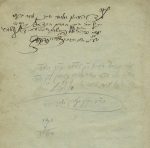The inscription in the Tosher Rebbe’s first copy of Kehilat Ya’akov, which recently sold at auction for $4,920 US. (photo from IMP Media Group Ltd.)
Even with the passing of the fourth Tosh Rebbe, Rabbi Meshulam Feish Segal-Lowy II, in 2015, Tosh Chassidut still exists in rural Quebec. The Tosh dynasty was founded in the 1800s and has roots in the Chassidic tradition, tracing their tradition back to the Ba’al Shem Tov.
Last month offered a unique opportunity to connect to the legacy of the Tosher Chassidut. The copy of Kehillat Ya’akov owned and used by the first Tosh Rebbe, Rabbi Meshulam Feish Segal-Lowy I, was available for auction at Kedem Auction House in Jerusalem. It was passed down within his family, and made it to the United States when his great-grandson fled Hungary. At the Nov. 15 auction, the item sold for $4,920 US.
The first Tosher Rebbe was a leading rabbi in the greater Jewish community in Hungary due to his standing in Torah and commitment to helping Jews. A 1966 article in the Canadian Jewish News by Norman Abrahams described the Tosher Rebbe’s dedication to his followers, many of whom were Holocaust survivors who turned to him for guidance: “This great man stays up most of the night fulfiling the many requests for advice and prayer and it is not uncommon to see him eating breakfast, his first meal of the day at five o’clock in the afternoon.”
Born in 1811 in Moravia (part of modern-day Czech Republic), Lowy I gained a reputation for his holiness and ability to perform miracles and became the first Tosh Rebbe, as well as a leading rabbi in Hungary. He received rabbinic ordination from Rebbe David (Spira) of Dynow, one of the leading rabbis of his time.
Although he passed away at 62, the first Tosher Rebbe had enormous impact on Torah Judaism. Lowy I served as rabbi and av beit din (literally, father of the court) of the city of Nyirtass, Hungary, and was known for his commitment to Torah. People came from all over to receive his blessings.
In 1873, a cholera epidemic broke out and killed almost 200,000 people in Hungary alone. The rebbe prayed to be an atonement for the Jews and, after his death, the epidemic did indeed come to an end.
The Tosh dynasty continued after Lowy I’s death, but was almost completely destroyed during the Holocaust. His namesake and great-grandson, Lowy II, was appointed rebbe by the few surviving Chassidim of his father, Rebbe Mordechai Marton Lowy, who was murdered in Auschwitz with most of his extended family.
Lowy II was born in Nyirtass in 1921, managed to survive the Holocaust in the Hungarian Labor Service and was liberated by the Red Army from a camp outside Marghita in October 1944. In 1946, he married Chava Weingarten, a direct descendant of the Noam Elimelech (Rebbe Elimelech Weisblum of Lizhensk). After being appointed rebbe, he set up court in Nyiregyhaza, but, in 1951, fearing the communist government, he ordered his followers to leave Hungary and immigrated to Canada, settling in Montreal.
Committed to maintaining the integrity of the Chassidut that his great-grandfather had started, and concerned about outside influence, in 1963, he decided to move his Chassidim to Boisbriand, Que., a small rural area now known as Kiryas Tosh.
After his death in 2015, Lowy II’s son, Rabbi Elimelech Segal-Lowy, became the next Tosher Rebbe.
The piece of Tosh history that was for sale is also inscribed by the first Tosh Rebbe’s grandson, Rabbi Moshe Shmuel Rottenberg, who received it from his father, Rabbi Yehosef HaLevi, author of Bnei Shileshim.

